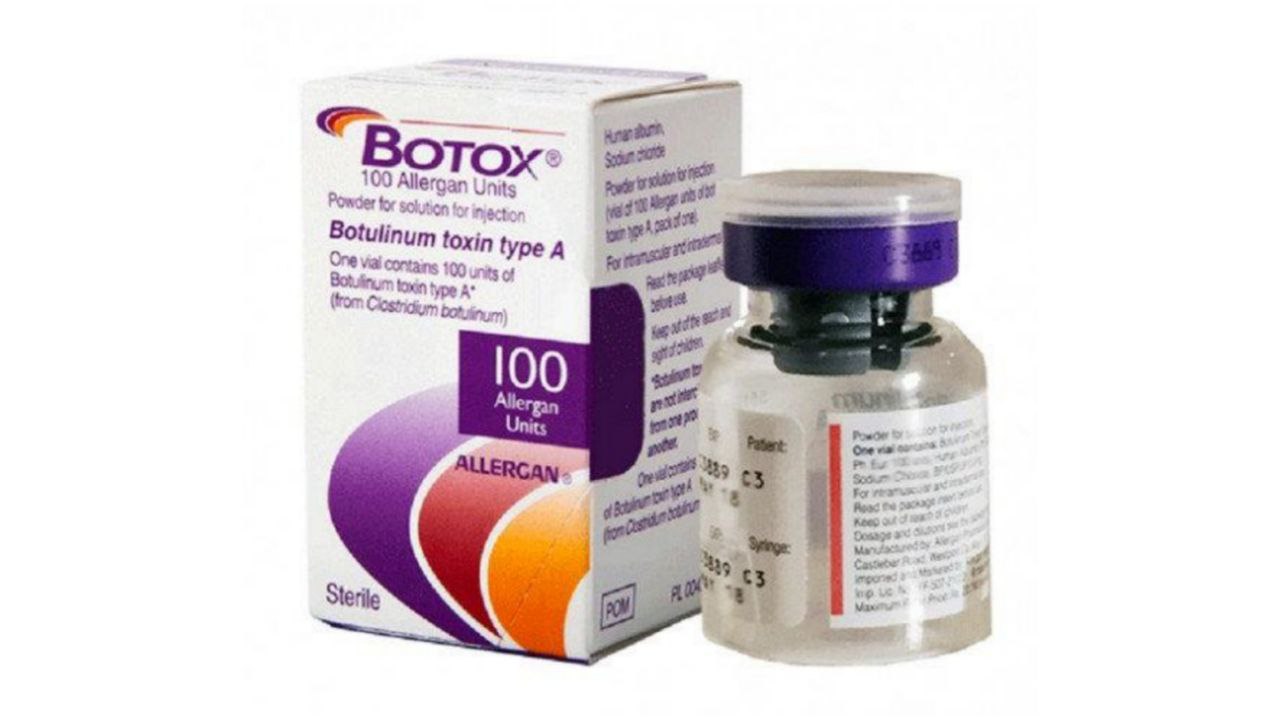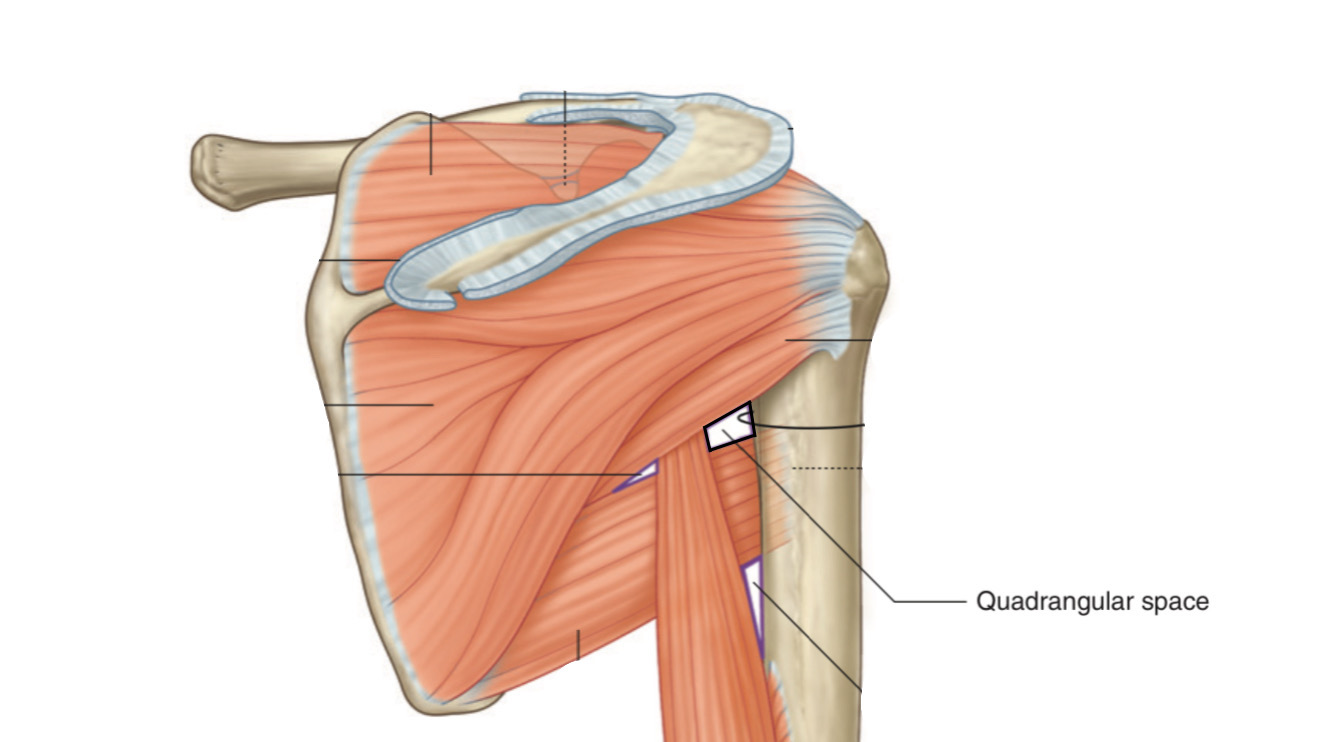
Quadrangular Space
By : Amna MohammedDefinition
It is an intermuscular space, also known as quadrilateral space or foramen humerotricipitale
Location
It is located below the shoulder (glenohumeral) joint.
The Borders
Superiorly: Subscapularis m., Teres minor m. , Capsule of the shoulder joint
Inferiorly: Teres major m.
Medially: The long head of triceps m.
Laterally: The surgical neck of the humerus bone
Inferiorly: Teres major m.
Medially: The long head of triceps m.
Laterally: The surgical neck of the humerus bone
Note\ For some sources, there is a diversity to the muscle that is considered as the superior border, in the anterior view, the subscapularis m. appears as the superior border, in the posterior view, the teres minor m. appears as the superior border.
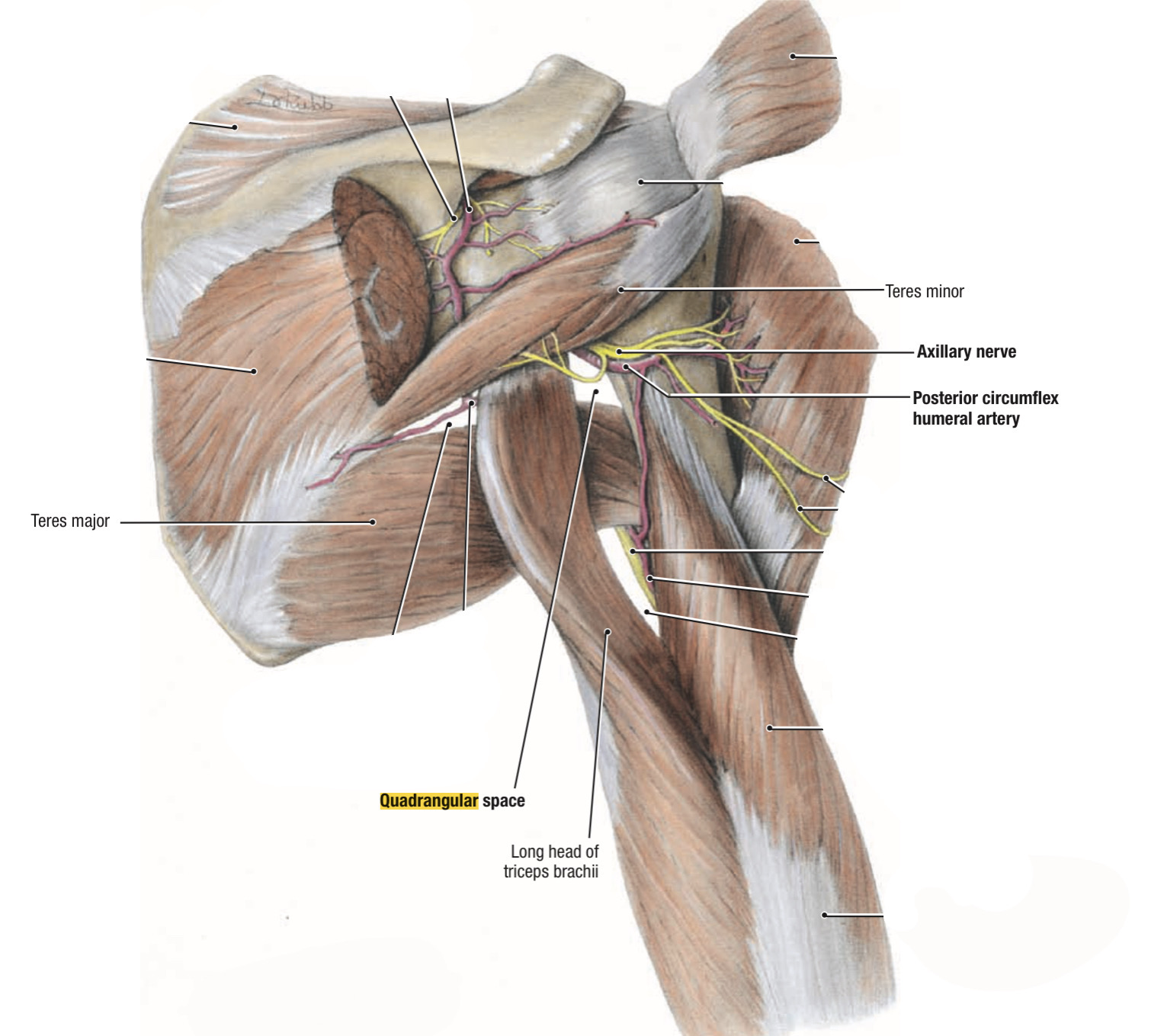
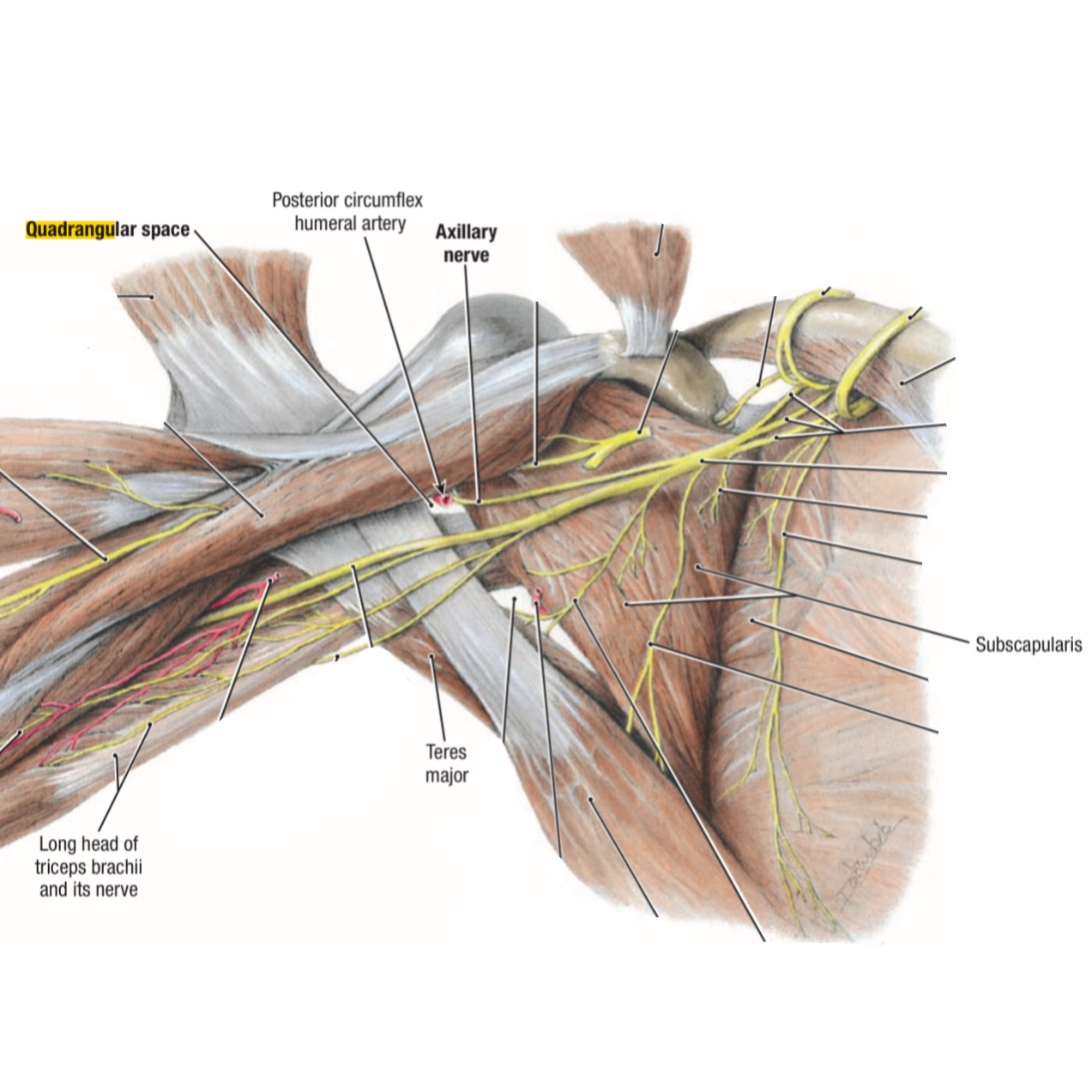
Quadrangular space
Posterior view ,right upper limb.
The contents
There are two structures that pass through the quadrangular space (1 nerve, 1 artery):
1. Axillary nerve
Its fibers arise from the posterior cord of the brachial plexuses.
divides after passing through the space into:
a) The anterior branch that innervates the deltoid m. & the skin over it.
b) The posterior branch that innervates the teres minor m. & continue as the superior lateral cutaneous nerve of the arm.
2. Posterior circumflex humeral vessels
It is a branch of the 3rd part of the axillary artery
winds around the surgical neck of the humerus bone after passing through the space to share with arterial anastomosis around the shoulder joint.
1. Axillary nerve
Its fibers arise from the posterior cord of the brachial plexuses.
divides after passing through the space into:
a) The anterior branch that innervates the deltoid m. & the skin over it.
b) The posterior branch that innervates the teres minor m. & continue as the superior lateral cutaneous nerve of the arm.
2. Posterior circumflex humeral vessels
It is a branch of the 3rd part of the axillary artery
winds around the surgical neck of the humerus bone after passing through the space to share with arterial anastomosis around the shoulder joint.
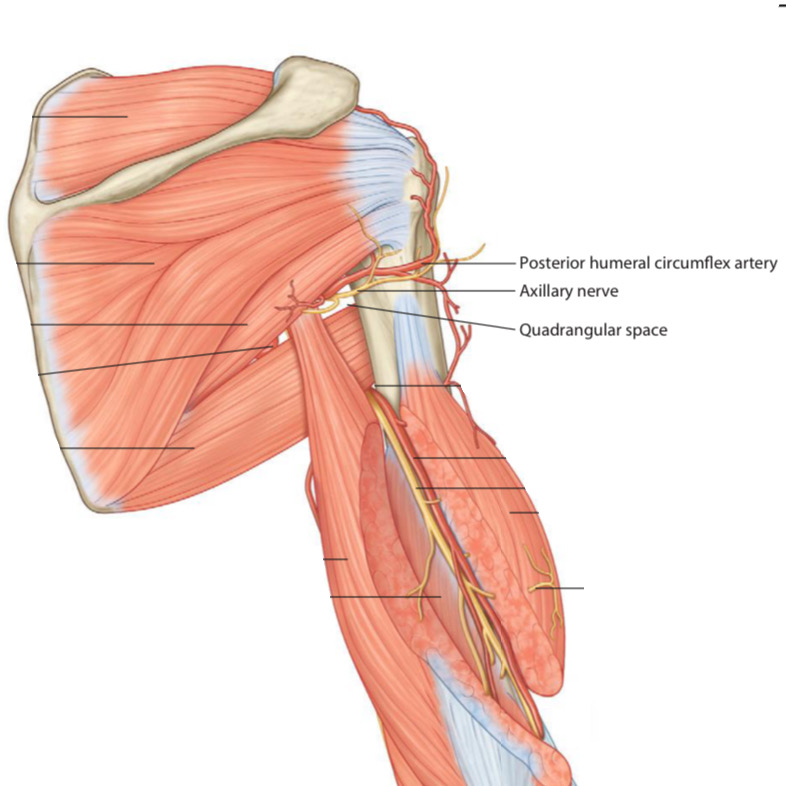
Posterior view, right upper limb.
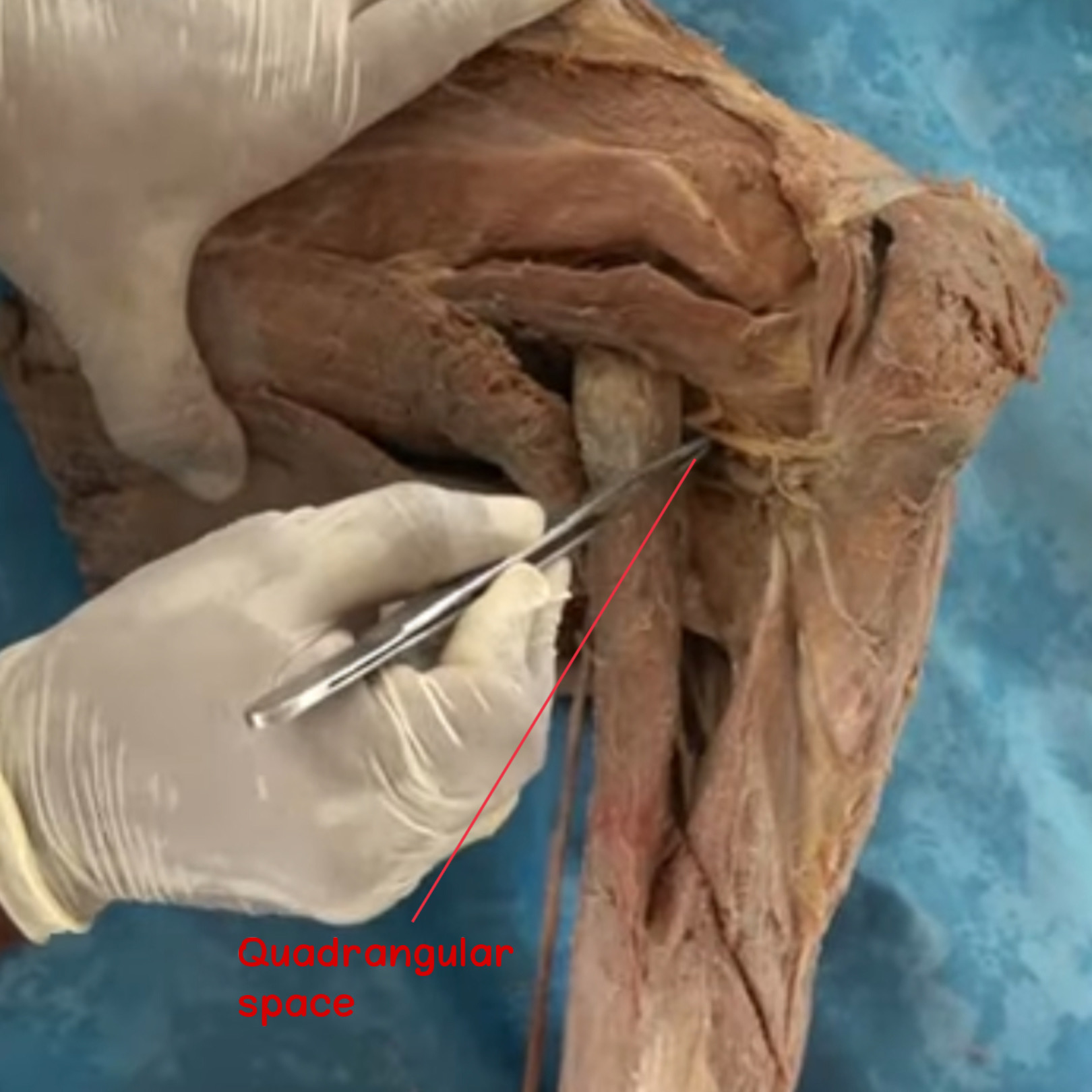
Posterior view, right upper limb.
Clinical importance
This space considers a passageway from the anterior region of the axilla to the posterior region of it.
This space is also vulnerable to “Quadrilateral space syndrome” .
This space is also vulnerable to “Quadrilateral space syndrome” .
Quadrilateral space syndrome (QSS)
A rare condition that the neural & vascular structures are entrapped in the quadrilateral space for some reason.
The possible causes of QSS
Any movement or structure that decreases the area of the quadrilateral space so causes compression on the structures that pass through it.
1. Fibrous bands which causes compression to the contents during shoulder abduction & external rotation .
2. Scapular bone fracture.
3. Benign or malignant mass.
1. Fibrous bands
Note
( located between the teres major m. & long head of the triceps m.)2. Scapular bone fracture.
3. Benign or malignant mass.
The Symptoms
1. A little pain in the shoulder.
2. Non-cutaneously tingling on the lateral side of the shoulder & arm.
These symptoms which are shown above, are increased during shoulder abduction & external rotation.
3. Insensitivity over the quadrilateral space on palpation.
4. Neurotrophic loss of teres minor m. & deltoid m.
2. Non-cutaneously tingling on the lateral side of the shoulder & arm.
These symptoms which are shown above, are increased during shoulder abduction & external rotation.
3. Insensitivity over the quadrilateral space on palpation.
4. Neurotrophic loss
Note
Neurotrophic loss means loss of neural conduction of the muscleThe Diagnosis
1. The specialist uses plain radiographs to detect fractures or any mass that cause pressure on the structures.
2. The specialist uses the EMG to test the activity of the axillary nerve & exclusion of other nerve pain causes.
3. The specialist uses MRI images or CT to detect muscle atrophy
Note
diminution of the size of the muscle or stop the growth of the muscles.
Note\ The modern method that uses to diagnose the QSS is to inject a lidocaine fluid in a certain percentage at a selected point on the shoulder region, if the pain is decreased & the patient can perform the shoulder movements without pain, the test is considered positive.
The treatment
1. The treatment is non-surgical treatment including non-steroidal anti-inflammatory drugs ( NSAIDs), alteration of the activity & physical therapy.
2. If this method won’t work to decrease the pain for 6 months, surgical treatment is needed in this case & the surgery method is dependent on the surgeon’s experience & the available equipment.
Note
a set of medicines that work as a painkiller2. If this method won’t work to decrease the pain for 6 months, surgical treatment is needed in this case & the surgery method is dependent on the surgeon’s experience & the available equipment.
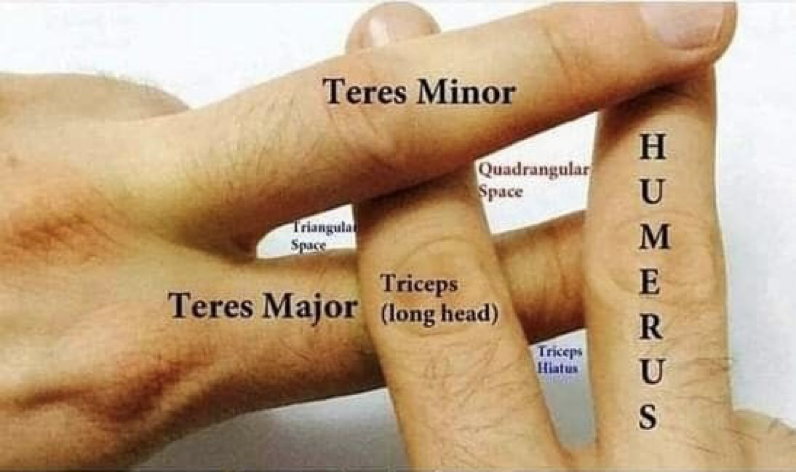
A simple way to memorize the borders of the anatomical spaces in the upper limb.
References
Snell’s Clinical Anatomy By Regions (10th Edition) 258,349,374_375-376
BD_Chaurasia’s_Human_Anatomy, Volume 1 - Upper Limb Thorax (6th Edition) 71
Gray’s Anatomy For Students (4th Edition) 719
Advanced Techniques in Musculoskeletal Medicine & Physiotherapy 113
Quadrilateral space syndrome- Journal of Shoulder and Elbow Surges http://bonefix.co.nz/portals/160/images/Flynn%20Quadrangular%20space%20syndrome.pdf
Nonsteroidal Anti-inflammatory Drugs (NSAIDs)- Books- https://www.ncbi.nlm.nih.gov/books/NBK547742/
Quadrilateral Space Syndrome- physipedia- https://www.physio-pedia.com/Quadrilateral_Space_Syndrome
Grant’s Atlas Of Anatomy (13th Edition )6.42, 6.28
Gray’s Atlas Of Anatomy (2nd Edition) 414
https://youtu.be/YetQwcWCuFQ
Fig 5-The way to memorize- Pinterest- https://pin.it/10zLzjN
Snell’s Clinical Anatomy By Regions (10th Edition) 258,349,374_375-376
BD_Chaurasia’s_Human_Anatomy, Volume 1 - Upper Limb Thorax (6th Edition) 71
Gray’s Anatomy For Students (4th Edition) 719
Advanced Techniques in Musculoskeletal Medicine & Physiotherapy 113
Quadrilateral space syndrome- Journal of Shoulder and Elbow Surges http://bonefix.co.nz/portals/160/images/Flynn%20Quadrangular%20space%20syndrome.pdf
Nonsteroidal Anti-inflammatory Drugs (NSAIDs)- Books- https://www.ncbi.nlm.nih.gov/books/NBK547742/
Quadrilateral Space Syndrome- physipedia- https://www.physio-pedia.com/Quadrilateral_Space_Syndrome
Grant’s Atlas Of Anatomy (13th Edition )6.42, 6.28
Gray’s Atlas Of Anatomy (2nd Edition) 414
https://youtu.be/YetQwcWCuFQ
Fig 5-The way to memorize- Pinterest- https://pin.it/10zLzjN
